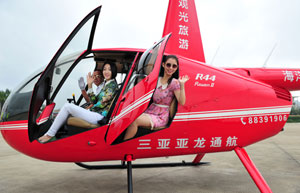Civil aviation industry growing with global integration
(Xinhua) Updated: 2014-01-09 13:48The fast-growing Chinese domestic market is generally credited with driving this transformation. According to the Shanghai-based Commercial Aircraft Corp, the number of passenger aircraft in China will rise from 1,969 in 2012 to 6,494 in 2032, accounting for 17 percent of the global total. Chinese enterprises and individuals are expected to purchase 5,357 aircraft with at least 50 seats, worth $647 billion, in that period.
Six years ago, Airbus forecast China would be the second-largest civil aviation market after the United States by 2025.
China's Ministry of Industry and Information Technology last year issued a medium and long-term development plan for the civil aviation sector, encouraging Chinese firms to engage more in global cooperation while welcoming foreign providers in domestic programs.
Since 2009, a series of high-level commercial interactions, including mergers and acquisitions, has helped China grow from "cheap aircraft manufacturer to important business partner," noted Chen.
In 2010, the AVIC began working with Canada's Bombardier to design, manufacture and sell aircraft together. In 2011, the AVIC formed a partnership with GE to build an avionics company. To support development of the C919, China's largest domestically manufactured aircraft, the AVIC has partnered with almost all international aircraft manufacturers.
Exports of China-developed aircraft have helped China broaden connections with the world, but until recently the long-term challenge was getting China-made aircraft flying abroad.
The MA60 was the first regional turboprop made in China in line with international airworthiness criteria. But these models, first produced in 2000, stood on the parking apron for years before exports began in 2005.
Since then, international demand for MA aircraft has boomed, with 90 deliveries and 200 orders involving 200 airlines in 15 countries.
"Our core competence is developing customized quality products at competitive costs," Chen explained. "That is the key to achieving success in developing markets in Asia, Africa and Latin America."
In recent years, it was hard to imagine China would export aircraft, said Wang Yue, vice-president of A. BRAIN, a leading manufacturing consultancy. "Today, though. Chinese-made aircraft are shouldering a large volume of traffic in many countries, having been universally recognized."
At the end of last century, it was estimated that the techonology level of China's civil aircraft manufacturers lagged about 20 years behind that of Western counterparts, but this is steadily narrowing.
Civil aviation in the country is getting stronger with integration into the global chain. In 2013, the AVIC ranked number 212 in the Fortune 500 list.
- NHTSA says finds no 'defect trend' in Tesla Model S sedans
- WTO rare earth ruling is unfair
- Amway says 2014 China sales may grow 8%
- President Xi in Europe: Forging deals, boosting business
- CNOOC releases 2013 sustainability report
- Local production by Chery Jaguar Land Rover this year
- Car lovers test their need for speed in BMW Mission 3
- China stocks close mixed Monday

















